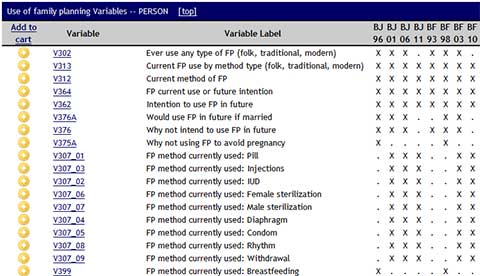DHS Data Now Available in Integrated, Customized Package from the Minnesota Population Center
Have you ever wished that you could download just one dataset for multiple surveys with all of the data you want for your analysis in one file? And that the dataset wasn’t so huge and overwhelming? And that the variables in the dataset were all harmonized?

The Minnesota Population Center has been working on the Integrated Demographic and Health Series (IDHS), a free online database that currently includes over 2,000 integrated variables from 76 DHS surveys in 18 countries. (If you know IPUMS data, these are the DHS equivalent.) These variables are harmonized for consistency across time and across countries. The IDHS are also painstakingly documented, letting you, the researcher, know how different items have been defined and coded, with each variable’s codes and frequencies, question wording, universe, meaning, and comparability issues accessible with just a click. The variable selection tool lets you see, at a glance, which surveys have included that specific variable, allowing you to select the variables and surveys you need for your analysis. The customized datasets come packaged with the survey year and country, weights, identifiers, and other sampling variables needed for analysis, and in the format you chose (SAS, Stata, SPSS, ASCII, or CSV file).
IDHS data are currently available for 18 countries and 76 surveys, allowing for comparative analysis for many countries in sub-Saharan Africa as well as India and Egypt. All of the countries included have had at least 3 DHS surveys dating back to the 1980s, so these harmonized datasets are perfect for trend analysis. Researchers can select either women or children as their unit of analysis. The variables cover questions about the woman herself, such as her education, media exposure, marital history, contraceptive knowledge and use, family size desires, experience of domestic violence, and knowledge about illnesses such as HIV/AIDS, tuberculosis, and fistula. Other questions relate to the health of the woman’s children under 5, such as antenatal and delivery care, nutrition, vaccinations, and recent diarrheal and respiratory illnesses and treatment.
What’s the difference between IDHS data and DHS datasets? Who should use IDHS data?
DHS datasets continue to be available for download from The DHS Program website by country. The datasets include all of the data collected in a survey. If you are looking to analyze a single data set, the DHS datasets are likely your best bet. But for a multi survey analysis (among the 18 countries currently included in the IDHS and limited to the women and children), try the harmonized packages from IDHS.
What’s next?
IDHS has funding to continue this project through 2016 and will seek continued funding for another five years of work. They will continue launching data from more countries, new DHS surveys as they become available, and hope to expand to cover men and households.



It’s wonderful! I am very excited to reaching the IDHS database. Thanks